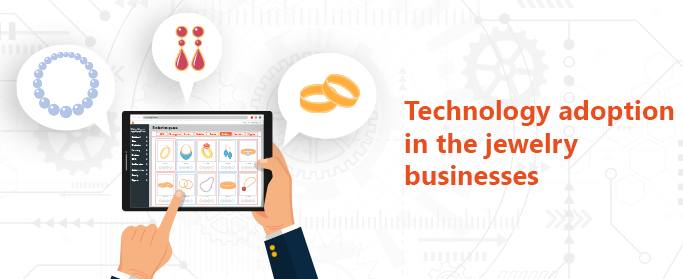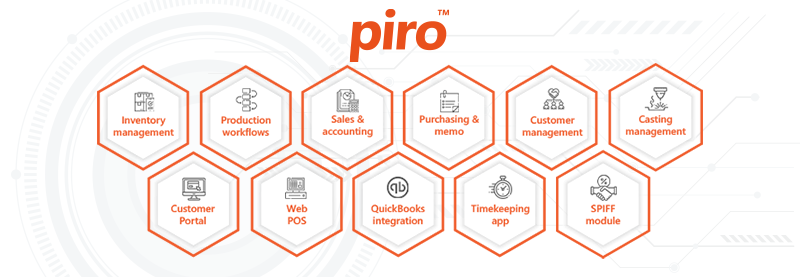It would be absurd to claim that the jewelry industry does not embrace the latest technologies. Everyone is aware of the advantages CAD and 3D printing bring to manufacturing. The COVID-19 pandemic also accelerated the need for retail companies to establish omnichannel strategies. Being present online has become a necessity - one of the most compelling lessons from the pandemic.
This continued digitalization of the industry, along with shifting consumer values, is creating new opportunities and challenges for fine jewelry brands. The digital transformation of the jewelry industry is a slow yet continuous process.

Join me as we explore the present and near future of technological advancements in this space.
Technology that will Impact the industry and your business in 2025

Online Presence
The first and most widely recognized shift is the necessity of an online presence. With both current and digitally native generations searching for everything online, accessibility is essential. This does not mean that customers who discover a brand online will necessarily complete their purchases there. That is why an omnichannel experience is still crucial in 2025.
Before entering a store, a customer will likely have already read online reviews and explored the available jewelry collections. Among e-commerce platforms, Shopify has emerged as a dominant force.

CAD/CAM Technology
CAD/CAM has been in use for a long time - not only by manufacturers but also by retailers. Custom jewelry offers a unique experience for buyers, making it highly attractive. Even retailers who do not manufacture in-house often employ CAD specialists to expedite the design process efficiently.
![jewelry software]() 3D Printing
3D Printing
The use of 3D printing in jewelry manufacturing is no longer a novelty. This technology continues to evolve with advancements such as LCD printers, DLP (Digital Light Processing) printers, and SLA (Stereolithography) printers, making the process more affordable and efficient.
![jewelry software]() Lab-Grown Diamonds
Lab-Grown Diamonds
Though not directly related to internal company operations, lab-grown diamonds significantly impact the jewelry market. With sustainability considerations gaining importance, incorporating lab-grown diamonds into a brand’s offerings is a logical step for many jewelry businesses.
![jewelry software]() Business Management Systems
Business Management Systems
Running a business today without management software is increasingly challenging. Several systems can be utilized, including CRM, MRP, POS, or an ERP system that integrates all of these. One such system, PIRO, allows businesses to centralize their operations, making it an essential tool for manufacturing, retail, online sales, and customer management.
The Role of Business Management Systems

Customer-centric tools are indispensable because they define a brand's identity and service quality.
Meanwhile, business management systems support internal operations, allowing companies to plan, respond swiftly to customer demands, and navigate challenges efficiently.
Digital transformation is not just about moving away from Excel spreadsheets - it’s about implementing systems that automate online sales channels, inventory tracking, and production for optimal business efficiency.
Which technologies or tools should you wait before implementing?
While early adoption of new technology can provide a competitive edge, being among the first adopters is not always beneficial. Consider the early Tesla owners who later found their battery cells outdated within a few years.
It is often wiser to observe how a technology evolves before integrating it into business operations. Here are some technologies where waiting might be the better option:
AI and Generative Design
 Despite AI’s rapid progress, jewelry businesses should not hastily replace CAD designers. While AI-driven jewelry design tools are on the horizon, they are not yet fully developed. Today, true AI-designed jewelry does not exist - only AI-inspired designs that still require human expertise in programs like Matrix or Rhino. It is worth waiting for these platforms to refine their AI capabilities before making drastic changes.
Despite AI’s rapid progress, jewelry businesses should not hastily replace CAD designers. While AI-driven jewelry design tools are on the horizon, they are not yet fully developed. Today, true AI-designed jewelry does not exist - only AI-inspired designs that still require human expertise in programs like Matrix or Rhino. It is worth waiting for these platforms to refine their AI capabilities before making drastic changes.
Augmented Reality (AR) and Virtual Try-Ons
 AR can enhance customer confidence in purchasing jewelry online. However, should businesses rush to adopt this technology? Probably not. It is better to observe market reactions first. Does virtual try-on technology genuinely drive more sales?
AR can enhance customer confidence in purchasing jewelry online. However, should businesses rush to adopt this technology? Probably not. It is better to observe market reactions first. Does virtual try-on technology genuinely drive more sales?
While AR and holographic jewelry displays have appeared at trade shows, its practical application in retail stores remains rare. Let’s remember how Facebook once believed that people would want to hold meetings in the Metaverse - only to see little real adoption.
I believe we can wait on virtual try-ons, especially as a generation fully immersed in digital technology is just now coming of age.
 Smart Jewelry – Smart Rings and Smart Bracelets
Smart Jewelry – Smart Rings and Smart Bracelets
I might be wrong, but I think wearable IoT-enabled smart jewelry will remain a niche market. Jewelry – in the traditional sense – is not primarily worn for functionality but for status and aesthetic value. Therefore, this segment is unlikely to see widespread adoption and surpass traditional jewelry soon.
AI-Driven jewelry ERPs
Many software providers are jumping on the AI trend, offering various AI-powered features. However, their true value is still uncertain. ChatGPT-based, auto-generated product descriptions may enhance efficiency, but sacrificing creativity for speed may not always be worthwhile.
AI has long-term potential in business management software, particularly for reporting and forecasting. For example, an AI-powered ERP system could analyze customers' online behavior and suggest optimal stock levels.
However, integrating AI into ERP systems is a complex process. As seen with the competition between DeepSeek and OpenAI, waiting for AI to become more accessible and easier to train is a smarter strategy.
Blockchain Technology
 Sustainability, ethical sourcing, and minimizing environmental impact are growing priorities for the market, yet it remains difficult to verify whether customers truly receive products that meet these standards.
Sustainability, ethical sourcing, and minimizing environmental impact are growing priorities for the market, yet it remains difficult to verify whether customers truly receive products that meet these standards.
Blockchain technology seems like an obvious solution to these challenges. Companies such as Everledger (facing financial issues), Tracr (by De Beers Group), and TrustChain (by Richline Group) have attempted to implement blockchain in the jewelry industry. However, despite the buzz, the industry does not seem eager to embrace full transparency.
Widespread adoption of blockchain in jewelry is still pending. Smaller jewelry businesses are unlikely to hire blockchain experts for implementation. Widespread adoption will only occur once the technology becomes more democratized, standardized, and user-friendly.
Final Words
Some technologies have already become industry standards, often interconnected. Running an online sales channel without specialized jewelry management software is increasingly difficult, as such systems consolidate all sales channels while also managing back-office operations. PIRO is one such solution.
Meanwhile, certain emerging technologies are expected to gain traction over the next 3–6 years. AI will undoubtedly enhance design possibilities and ERP capabilities. However, businesses do not need to rush into adoption, as exponential technological advancements suggest that waiting for the second wave may be more strategic.
Ultimately, the most important takeaway is to undergo digital transformation as soon as possible. Without digital infrastructure, implementing new technologies becomes impossible. Running a jewelry business through outdated spreadsheets will not suffice in a rapidly evolving market.

 3D Printing
3D Printing Lab-Grown Diamonds
Lab-Grown Diamonds Business Management Systems
Business Management Systems




